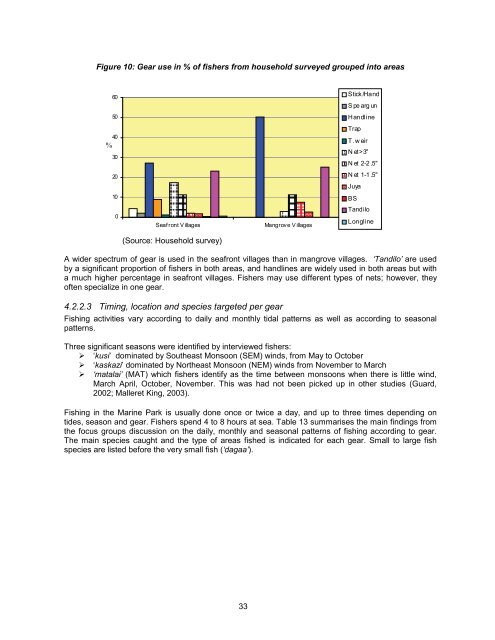a socio-economic baseline assessment of the mnazi bay - IUCN
a socio-economic baseline assessment of the mnazi bay - IUCN
a socio-economic baseline assessment of the mnazi bay - IUCN
Create successful ePaper yourself
Turn your PDF publications into a flip-book with our unique Google optimized e-Paper software.
Figure 10: Gear use in % <strong>of</strong> fishers from household surveyed grouped into areas<br />
60<br />
Stick/Hand<br />
Speargun<br />
50<br />
Handline<br />
%<br />
40<br />
30<br />
Trap<br />
T. weir<br />
Net>3"<br />
N et 2-2 .5"<br />
20<br />
N et 1-1 .5"<br />
Juya<br />
10<br />
BS<br />
0<br />
Seaf ront V illages<br />
Mangrove V illages<br />
Tandilo<br />
Longline<br />
(Source: Household survey)<br />
A wider spectrum <strong>of</strong> gear is used in <strong>the</strong> seafront villages than in mangrove villages. ‘Tandilo’ are used<br />
by a significant proportion <strong>of</strong> fishers in both areas, and handlines are widely used in both areas but with<br />
a much higher percentage in seafront villages. Fishers may use different types <strong>of</strong> nets; however, <strong>the</strong>y<br />
<strong>of</strong>ten specialize in one gear.<br />
4.2.2.3 Timing, location and species targeted per gear<br />
Fishing activities vary according to daily and monthly tidal patterns as well as according to seasonal<br />
patterns.<br />
Three significant seasons were identified by interviewed fishers:<br />
‘kusi’ dominated by Sou<strong>the</strong>ast Monsoon (SEM) winds, from May to October<br />
‘kaskazi’ dominated by Nor<strong>the</strong>ast Monsoon (NEM) winds from November to March<br />
‘matalai’ (MAT) which fishers identify as <strong>the</strong> time between monsoons when <strong>the</strong>re is little wind,<br />
March April, October, November. This was had not been picked up in o<strong>the</strong>r studies (Guard,<br />
2002; Malleret King, 2003).<br />
Fishing in <strong>the</strong> Marine Park is usually done once or twice a day, and up to three times depending on<br />
tides, season and gear. Fishers spend 4 to 8 hours at sea. Table 13 summarises <strong>the</strong> main findings from<br />
<strong>the</strong> focus groups discussion on <strong>the</strong> daily, monthly and seasonal patterns <strong>of</strong> fishing according to gear.<br />
The main species caught and <strong>the</strong> type <strong>of</strong> areas fished is indicated for each gear. Small to large fish<br />
species are listed before <strong>the</strong> very small fish (‘dagaa’).<br />
33
















